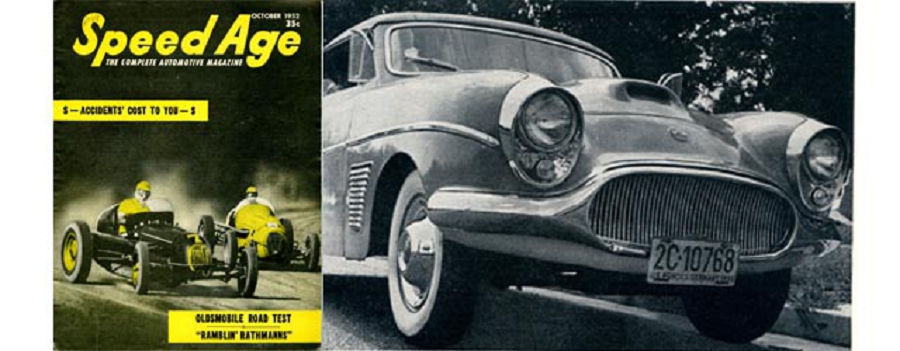
Hi Gang…
Here’s another great article about a beautifully built Spohn custom car. There has been some discussion about where the styling came from in terms of “timing.” Who did what – when, where, and first?
So far, we have found no truth to the rumor that Harley Earl saw what Spohn was doing and copied those features for both of his showcars – the GM LeSabre and the Buick XP300. The evidence in terms of timing in magazine articles as well as Josef Eiwanger’s (who owned and ran Spohn Coachworks in the ‘40s and ‘50s) participation in an article about Spohn in the ‘70s, confirm exactly where the styling came from – GM first; Spohn second.
Click here to review the 1974 article about Spohn in Special Interest Autos.
What’s interesting about the car in today’s story, is that it is the earliest documented (so far) with the styling features discussed above. In fact, it may have been the first one. Let’s see what the article had to say
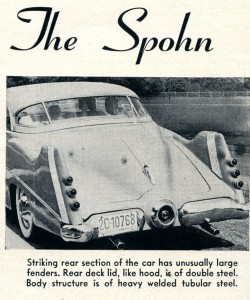 A Custom Job Called The Spohn
A Custom Job Called The Spohn
Text and Photos by William Clark
Speed Age, October 1952
Eleven years ago the underpinning of this slick and different custom car was a stock and very ordinary Ford. That was before it went to Germany with Major Jack T. Chandler of the USAAF by way of Huntsville, Texas. Influenced by the Buick XP300 and the Le Sabre, Major Chandler did the designing but turned over the building to Ravensburg Gaerm, a company that had customized cars for Herr Goebbels in the Hitler era.
Unlike many custom jobs, the Major’s design features normal road clearance and window height. Hood and rear deck lids are double steel. Although all parts are hand-formed, the fit and contour are remarkably smooth. The quick release top is formed of steel, covered with fabric and padded.
The hood follows the pattern of the German Veritas racing car and features a ram scoop which feeds air directly into the single carburetor. Body structure is of welded tubular steel and the bumpers are also hand-formed.
Interior is finished in heavy plastic, tan and green. The front seat is divided with a radio enclosed in the center section. Power plant, while the Major was in German, was a ’41 Ford. However, now that he’s home, Major Chandler is planning changes under the hood.
His Spohn…..trade name of the German firm….may soon sport a new overhead valve power plant, Major Chandler says.
Summary:
As I mentioned before, this is the earliest article that Wayne Graefen and I have found yet showing the styling taken from both the GM LeSabre and Buick XP 300 show cars. And, the Chandler Spohn may be the prototype for all Spohn customs with this front and rear end treatment – based on what is shared in terms of the article above.
The earliest article about Spohn ’50s customs that we have been able to document was printed in June ’52 Motor Trend, and these GM styling features were NOT exhibited on this car.
More research, more documentation, more work, and more fun with researching Spohn custom cars remain!
Hope you enjoyed the story, and until next time…
Glass on gang…
Geoff
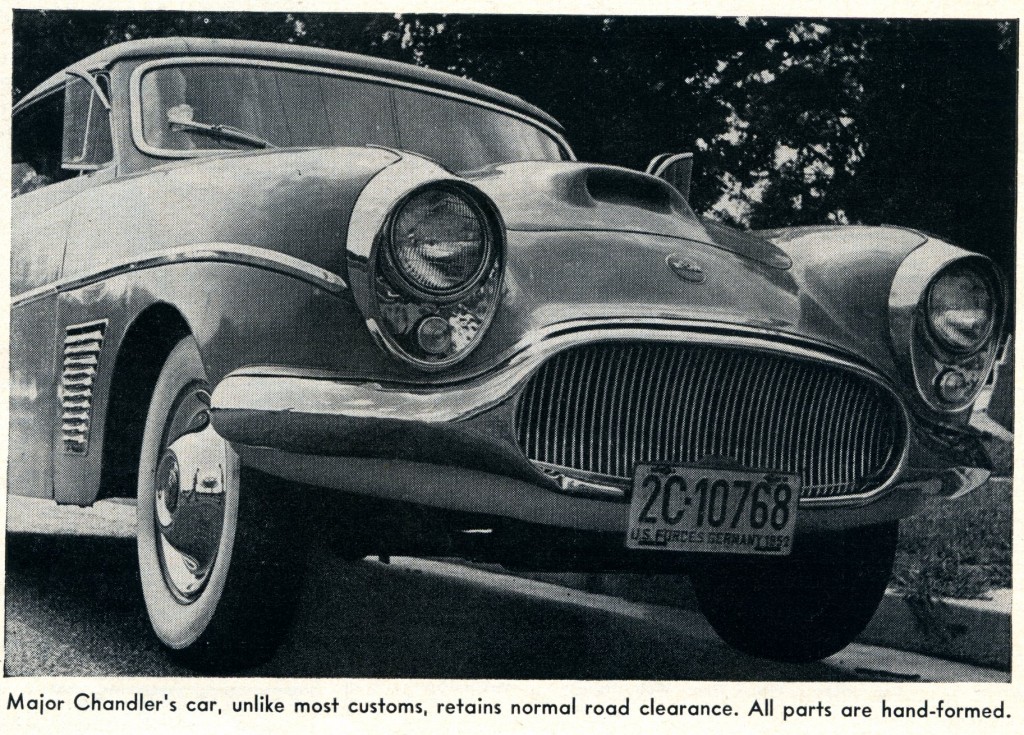
——————————————————————-
Click on the Images Below to View Larger Pictures
——————————————————————-


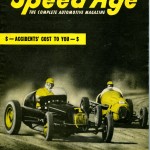
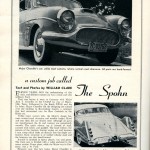
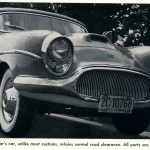
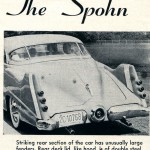
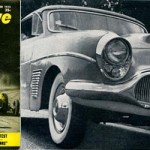
Ted…interesting questions and great points. The best I can do is continue to canvas the magazines and literature to see what we can find. And I’ll share anything here on Forgotten Fiberglass so we can see what each of us thinks concerning “new finds.”
Thanks for your continued interest and contributions, and keep ’em coming!
Geoff Hacker
Forgotten Fiberglass
THIS CONSPIRACY THEORY IS GOING TO KEEP CAR ENTHUSIASTS OUT OF THE PUBS FOR A LONG TIME. I CANNOT UNDERSTAND IF THE FIN DESIGN (AND HE LOVED FINS), WAS EARL’S, WHY HE LET SPOHN TURN THEM OUT IN SUCH NUMBERS? SURELY THERE WOULD HAVE BEEN SOME PATENT OR COPYRIGHT ON IT, AND IF SO WHO HAD IT. WHY WERE THEY ONLY BUILT BY SPOHN? IF IT WAS SUCH A CRAZE, WHY DIDN’T ANY RETURNED MEN OR ORDINARY AMERICANS ASK AMERICAN CUSTOMIZES LIKE BARRIS TO BUILD SOME? THE GREAT MAN (EARL) VISITED EUROPE AND EUROPEAN CAR SHOWS QUITE OFTEN, I SUPPOSE LOOKING FOR FRESH IDEAS, WHICH BRINGS ME TO A QUESTION NOBODY HAS MENTIONED. THE PUBLIC FIRST SAW THE LE SABRE IN 1951? THE SAME YEAR THE RUSSIANS SHOWED THE ZIS 112. ANY COINCIDENCE? IT WAS ALL SIXTY ONE LONG YEARS AGO.
This is for the most part all ‘bunk’. Spohn had become a customizer. His days of Coach Built cars was over. At this point Automotive Styling was not patent in the US. One of the last cars with a US Patent Office record was the 810 Cord.
Harley Earl ‘loved’ jet aircraft fins. That is what inspired him. The LeSabre was in the developement stages for a couple of years before it was shown. GM was not woried about any financial impact a German Customizer would have.
Why would any American Kustom shop copy them? The idea of customizing cars in a small shop is for the builder to show his own skills and ideas.
Harley Earl went to the Euro Auto Shows mainly prewar. By the late 1940s most anything important in design would be shown at the New York Auto Show as Europe was re-building. He like Raymond Lowey was not much at the drawing board. His staff put the ideas on paper and he sold it to management.
One other thing is that the end of WWII most American companier were broke. They did not have time to fool with some little ‘lead shed’ shop in Germany.
You can’t patent an idea!
As long as it was a fin of Spohn’s own design they could do as they wanted.
The 810 Cord was the last auto design patent. It was desided that there was nothing on the Cord that not been done, such as the fender lines. Earlier Dutch Darrin had won a case against Buick for their 1929 round beltline design copied from some of his French car bodies. This 29 Buick also had a new radiator shape because Packard objected to the 1925 to 1928 Buick design.
Many of these infringment cases were never carried out. In the casew of the Cord, ACD was out of business before any action was taken.
Meyers dune buggy bodies were another case. He tried to stop all the copy-cat builders. This ‘idea’ concept infringement never happened as the defendants said the idea came from the WWII Porsche designed VW jeep.
In more current times [1988] Ferrari put an end to the MERA 308 copy built on the Pontiac Fiero platform. Their defence was based on copyright infringement based on destroying the Ferrari immage. Ferrari won! It is a fine line between idea and corporate immage.
The real bottom line is the dollar effect on the original car design. Basically Spohn was no threat to GM. Look-a-like LeSabras only added to free publicity for General Motors.
In those days you could apply for a patent on an idea if you had a working model. That was an era when most of the 3rd world broke every copy-right on the American books. It was a cheap way to get a start in business – skipping the research and developement costs. If you take a look at prewar American advertising by gasoline and tire companys you will never see a real current car – they are all illustrations that only look a bit like American sized cars.
Noone in industry enforced what was going on in other parts of the world. In the 1960s when I was stationed in Taiwan, you could buy current American text books and best sellers for 10 cents [or less] on the dollar. The US Postal Service was the only one to block this. We could not mail books to to the United States through APO post offices. There was no protection of American auto designs. Even tin toy makers made models of current American designs. The American toy makers like Lionel rarely had anything but Lionel on their train cars. It required a royalty payment to the RR companies if you used their name or logo.
Spohn could get his hands on many American cars brought in by GIs and other US Government workers early post-war. I don’t see any evidence they designed cars, they just welded together auto sheet metal to make something a bit different. This was nothing new. Derham, an American coach-builder learned early on that it was easier and cheaper to move body panels around, sometimes from different makes of cars. Just one example they build a couple 48 Chrysler 2 doors up with early Lincoln Continental coupe roofs.
The industrial design dean at Art Center once quoted Harley Earl as saying ” I can roll up my pants legs, paint my legs with iodine and run around in front of the GM Buiding and be noticed., BUT not ingood taste”
Lt. Arthur Cooper, who owned the Monte Carlo-roofed, Sabre-tailed Spohn Custom, also took a Veritas into Spohn for the full custom treatment according to a phone interview with him some 15 years ago. We don’t know, but don’t think, that it was the same car that Hartung eventually owned. While Spohn bodied multiple cars for the Veritas firm, Eiwanger Jr. said that they built two Spohn Customs on used Veritas.
Keep in mind the year of the chassis has nothing to do with the year it was brought to Spohn for customization. Cooper’s US-based Custom is on a ’41 Packard, the Dezer collection Custom in Florida is thought to be a ’39 Ford chassis. My Spohn is based on a ’40 Ford chassis. Others were used Buicks, Cadillacs, Pontiacs or Mercurys.
Let’s see if we can find the Chandler Spohn and see what we find. Could be fun – and perhaps we’ll gather some other Spohn “goodies” along the way
In my mind, there is no question that the GM LeSabre came first – the story says that the Chandler Spohn car may have been the prototype for all Spohn cars that followed with the LeSabre tail treatment – I think that, perhaps, it was the Spohn Veritas Cabrio that set the stage for future Spohn LeSabre style cars. Maybe?
Wayne..
Keep on looking – I’ll buy you and Glenn the first round of drinks if you can confirm. What fun that would be
In the meantime, we’ll have to find some more Spohn cars to spread around the fun…
Best..
Geoff
There can be “almost” no doubt that Harley Earl’s GM Le Sabre, said to have been sketched in 1949, came first. However “never say never” because in the auto design world, there is so much spying going on that I would not doubt the possibility that Earl had spies visiting the coachbuilding houses throughout Europe as early as during and almost certainly after the war looking for inspiration from their portfolio sketches. Could Joe Eiwanger Sr., retiring manager of Spohn have penned this? Perhaps as he drew many great lines for the Euro Classics Spohn Carosserie bodied prior to WWII. But look, Harley was, without doubt one of the world’s great original stylists especially with future intentions.
As to which Sabre-tailed Spohn Custom came first, it is going to take a heckuva lot of research discoveries and as yet we don’t have enough cars extant (5), nor know their serial numbers (2) in order to draw meaningful conclusions. But every magazine article discovery adds a few more details to the Spohn Custom database I maintain.
Hi Glenn…
Glad you liked the article.
The person who ran Spohn confirmed he used GM styling. Not sure why this is in doubt. GM designs were used by Spohn – and confirmed by Spohn in several articles. Not the other way around.
Help stamp out rumors
Geoff
Another GREAT story! I’m wondering if, perhaps, the Veritas Spohn creation, that was sold at the Hartung auction, pre-dates this car. It was titled as a ’49 or ’50, but I don’t know when Spohn customized it with the LeSabre rear fin treatment. It’s the car that Lee Hartung told me that he thought it had been used in the TV Series of Boston Blackie.
The title date has nothing to do with the build date in the Spohn shop. Most of them were used cars imported by American GIs. The building of the GM LeSabre was under way in 1949. One of my friends had an older brother-in-law that was an engineer at AC division. He helped design the Fuel Injection system for It. The engine was basically the aluminum V8 that was later used in the 1961 Olds and Buick compacts [215 cid]. The bore and stroke were slightly different but both were 3.5L. At one point the LeSabre even got to Art Center School.